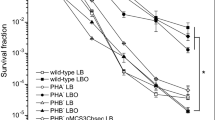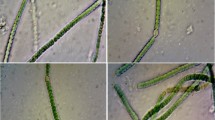Abstract
In this paper, we describe the UV and cold tolerance of a purple violet pigment (PVP)-producing Antarctic bacterium, Janthinobacterium sp. Ant5-2 (PVP+) and compared its physiological adaptations with a pigmentless mutant strain (PVP−). A spontaneous deletion of vioA that codes for tryptophan monooxygenase, the first gene involved in the biosynthesis of PVP was found in PVP− strain. The PVP− culture exhibited significantly reduced survival during exponential and stationary growth phase following exposure to UVB (320 nm) and UVC (254 nm) (dose range: 0–300 J/m²) when compared to wild-type (PVP+) cultures. In addition, upon biochemical inhibition of pigment synthesis by 2(5H)-furanone, wild-type PVP+ cultures exhibited approximately 50-fold growth reduction at a higher dose (300 J/m²) of UV. Increased resistance to UV was observed upon inducing starvation state in both PVP+ and PVP− cultures. There was 80 % (SD = ±8) reduction in extrapolymeric substance (EPS) production in the PVP− cultures along with a compromised survival to freeze–thaw cycles when compared to the PVP+ cultures. Perhaps synthesis of PVP and EPS are among the key adaptive features that define the survival of this bacterium in Antarctic extreme conditions, especially during austral summer months.







Similar content being viewed by others
References
Abedi-Moghaddam N, Bulic A, Henderson L, Lam E (2004) Survival of Escherichia coli to UV irradiation during exponential and stationary phases of growth. J Exp Microbiol Immunol 5:44–49
August PR, Grossman TH, Minor C, Draper MP, MacNeil IA, Pemberton JM, Call KM, Holt D, Osburne MS (2000) Sequence analysis and functional characterization of the violacein biosynthetic pathway from Chromobacterium violaceum. J Mol Microbiol Biotechnol 2:513–519
Battista JR (1997) Against all odds: the survival strategies of Deinococcus radiodurans. Annu Rev Microbiol 51:203–224
Caldas LR, Leitão AAC, Santos SM, Tyrrell RM (1978) Preliminary experiments on the photobiological properties of violacein. In: Tyrrell RM (ed) Proceedings of the International Symposium on Current Topics in Radiology and Photobiology. Academia Brasileira de Ciências, Rio de Janeiro, pp 121–126
Chattopadhyay MK (2006) Mechanism of bacterial adaptation to low temperature. J Biosci 31:157–165
Cockell CS, Horneck G (2001) The history of the UV radiation climate of the earth—theoretical and space-based observations. Photochem Photobiol 73:447–451
Dieser M, Greenwood M, Foreman CM (2010) Carotenoid pigmentation in Antarctic heterotrophic bacteria as a strategy to withstand environmental stresses. Arctic Antarctic Alp Res 42:396–405
Dietrich LE, Teal TK, Price-Whelan A, Newman DK (2008) Redox-active antibiotics control gene expression and community behavior in divergent bacteria. Science 321:1203–1206
Harsojo Kitayama S, Matsuyama A (1981) Genome multiplicity and radiation resistance in Micrococcus radiodurans. J Biochem 90:877–880
Hernandez ME, Newman DK (2001) Extracellular electron transfer. Cell Mol Life Sci 58:1562–1571
Huang J, Mojib N, Goli RR, Watkins S, Waites KB, Ravindra R, Andersen DT, Bej AK (2012) Antimicrobial activity of PVP from an Antarctic bacterium, Janthinobacterium sp. Ant5-2, on multi-drug and methicillin resistant Staphylococcus aureus. Nat Prod Biopros 2:104–110
Jagannadham MV, Rao VJ, Shivaji S (1991) The major carotenoid pigment of a psychrotrophic Micrococcus roseus strain: purification, structure, and interaction with synthetic membranes. J Bacteriol 173:7911–7917
Jagannadham MV, Chattopadhyay MK, Subbalakshmi C, Vairamani M, Narayanan K, Rao CM, Shivaji S (2000) Carotenoids of an Antarctic psychrotolerant bacterium, Sphingobacterium antarcticus, and a mesophilic bacterium, Sphingobacterium multivorum. Arch Microbiol 173:418–424
Jagger J (1983) Physiological effects of near-ultraviolet radiation on bacteria. Photochem Photobiol Rev 7:1–75
Jeffrey WH, Pledger RJ, Aas P, Hager S, Coffin RB, Von Haven R, Mitchell DL (1996) Diel and depth profiles of DNA photodamage in bacterioplankton exposed to ambient solar ultraviolet radiation. Mar Ecol Prog Ser 137:283–291
Jenkins DE, Schultz JE, Matin A (1988) Starvation-induced cross protection against heat or H2O2 challenge in Escherichia coli. J Bacteriol 170:3910–3914
Karentz D (1994) Considerations for evaluating ultraviolet radiation induced genetic damage relative to Antarctic ozone depletion. Environ Health Persp 102:61–63
Kolter R, Siegele DA, Tormo A (1993) The stationary phase of the bacterial life cycle. Ann Rev Microbiol 47:855–874
Logan NA (1989) Numerical taxonomy of violet-pigmented, gram-negative bacteria and description of Iodobacter fluviatile gen. nov., comb. nov. Int J Syst Bacteriol 39:450–456
Martinelli D, Grossmann G, Sequin U, Brandl H, Bachofen R (2004) Effects of natural and chemically synthesized furanones on quorum sensing in Chromobacterium violaceum. BMC Microbiol 4:25
Merritt JH, Kadouri DE, O’Toole GA (2005) Growing and analyzing static biofilms. In: Current Protocols in Microbiology, Wiley InterScience, New York, pp 1B.1.1–1B.1.17
Mojib N, Philpott R, Huang JP, Niederweis M, Bej AK (2010) Antimycobacterial activity in vitro of pigments isolated from Antarctic bacteria. Anton Van Leeuwen 98:531–540
Mojib N, Nasti TH, Atigada V, Hoover R, Yusuf N, Bej AK (2011) The antiproliferative function of violacein-like purple violet pigment (PVP) from an Antarctic Janthinobacterium sp. Ant5-2 in UV-induced 2237 fibrosarcoma. Int J Dermatol 50:1223–1233
Morita R (ed) (1997) Bacteria in oligotrophic environments: Starvation Survival Lifestyle. Chapman & Hall, New York, p 608
Morohoshi T, Kato M, Fukamachi K, Kato N, Ikeda T (2008) N-acylhomoserine lactone regulates violacein production in Chromobacterium violaceum type strain ATCC 12472. FEMS Microbiol Lett 279:124–130
Morohoshi T, Fukamachi K, Kato M, Kato N, Ikeda T (2010) Regulation of the violacein biosynthetic gene cluster by acylhomoserine lactone-mediated quorum sensing in Chromobacterium violaceum ATCC 12472. Biosci Biotechnol Biochem 74:2116–2119
Moseley BEB (1983) Photobiology and radiobiology of Micrococcus (Deinococcus) radiodurans. Photochem Photobiol Rev 7:223–274
Nicholson WL, Schuerger AC, Setlow P (2005) The solar UV environment and bacterial spore UV resistance: considerations for Earth-to-Mars transport by natural processes and human spaceflight. Mutat Res 571:249–264
Nienow JA, McKay CP, Friedmann EI (1988) The cryptoendolithic microbial environment in the Ross Desert of Antarctica: light in the photosynthetically active region. Microb Ecol 16:271–289
Notredame C, Higgins DG, Heringa J (2000) T-Coffee: a novel method for fast and accurate multiple sequence alignment. J Mol Biol 302:205–217
Nyström T, Olsson RM, Kjelleberg S (1992) Survival, stress resistance, and alterations in protein expression in the marine Vibrio sp. strain S14 during starvation for different individual nutrients. Appl Environ Microbiol 58:55–65
Otto AI, Riou L, Marionnet C, Mori T, Sarasin A, Magnaldo T (1999) Differential behaviors toward ultraviolet A and B radiation of fibroblasts and keratinocytes from normal and DNA-repair-deficient patients. Cancer Res 59:1212–1218
Panicker G, Aislabie J, Saul D, Bej AK (2002) Cold tolerance of Pseudomonas sp. 30–3 isolated from oil-contaminated soil. Antarctica. Pol Biol 25:5–11
Panicker G, Mojib N, Nakatsuji T, Aislabie J, Bej AK (2010) Occurrence and distribution of capB in Antarctic microorganisms and study of its structure and regulation in the Antarctic biodegradative Pseudomonas sp. 30–3. Extremophiles 14:171–183
Ponnusamy K (2010) 2(5H)-Furanone: a prospective strategy for biofouling-control in membrane biofilm bacteria by quorum sensing inhibition. Brazilian J Microbiol 41:227–234
Rainey PB, Moxon ER, Thompson IP (1993) Intraclonal polymorphism in bacteria. Adv Microb Ecol 13:263–300
Seymour RL, Mishra PV, Khan MA, Spector MP (1996) Essential roles of core starvation-stress response loci in carbon-starvation-inducible cross-resistance and hydrogen peroxide-inducible adaptive resistance to oxidative challenge in Salmonella typhimurium. Mol Microbiol 20:497–505
Staehelin J, Harris NRP, Appenzeller C, Ebenhard J (2001) Ozone trends: a review. Rev Geophys 39:231–290
Tomasko MG, Doose LR, Lemmon M, Smith PH, Wegryn E (1999) Properties of dust in the Martian atmosphere from the imager on Mars Pathfinder. J Geophys Res 104:8987–9007
Warneck P (1988) Chemistry of the natural atmosphere. Academic Press, New York
WHO (2002) Global Solar UV Index: a practical guide. A Joint Recommendation of the World Health Organization, World Meteorological Organization, United Nations Environment Programme, and the International Commission on Non-Ionizing Radiation Protection. WHO
Wynn-Williams DD, Edwards HGM (2001) Environmental UV radiation: biological strategies for protection and avoidance. Springer, Berlin
Yada S, Wang Y, Zou Y, Nagasaki K, Hosokawa K, Osaka I, Arakawa R, Enomoto K (2008) Isolation and characterization of two groups of novel marine bacteria producing violacein. Mar Biotechnol (NY) 10:128–132
Acknowledgments
We thank Col. (IL) J.N. Pritzker ARNG (Retired), Tawani Foundation (Chicago) for supporting the Tawani 2008 International Antarctic Scientific Expedition; Marty Kress, VCSI, Inc./NASA); NASA’s Astrobiology program; Dr. Rasik Ravindra, Director, NCAOR; 2008–2009 Maitri and Novolazarevskaya Station staffs; Maitri Cdrs. A. Chaturvedi, and Dr. P. Malhotra and Ashit Swain, Indian Geological Survey (Antarctic Division); and Richard B. Hoover (NASA) for assisting identification of the bacterial strain.
Author information
Authors and Affiliations
Corresponding author
Additional information
Communicated by A. Oren.
Electronic supplementary material
Below is the link to the electronic supplementary material.
Rights and permissions
About this article
Cite this article
Mojib, N., Farhoomand, A., Andersen, D.T. et al. UV and cold tolerance of a pigment-producing Antarctic Janthinobacterium sp. Ant5-2. Extremophiles 17, 367–378 (2013). https://doi.org/10.1007/s00792-013-0525-9
Received:
Accepted:
Published:
Issue Date:
DOI: https://doi.org/10.1007/s00792-013-0525-9




